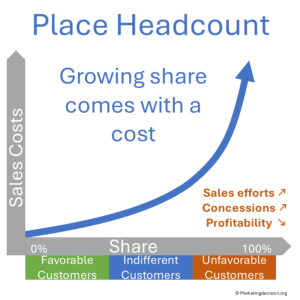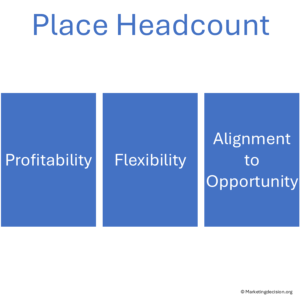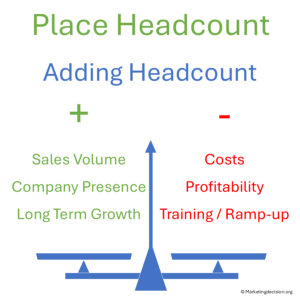Balancing go-to-market headcount with volume potential, market penetration, and profitability is a key strategic decision for any organization. Determining the optimal number of people within the overall organizational structure — across sales, marketing, operations, and support — is critical to ensure efficient market coverage and sustainable growth.
Discussions often arise between two opposing models — a large organization with extensive coverage across all market segments to increase share and presence, versus a leaner organization focusing on higher-margin segments with greater operational flexibility. Both models can be effective depending on market conditions, competitive pressure, and corporate growth strategy.
Such choices are part of the broader marketing mix considerations, influenced by cost, resource allocation, and presence. Adjusting a go-to-market organization is time-consuming, requiring hiring, training, and aligning territories and teams — all of which represent strategic resource management decisions. This is why Go-to-Market Headcount decisions are integral parts of business and go-to-market strategy planning.
 Adding new personnel usually comes with the expectation of increasing market share, but this relationship is not linear. Simply doubling the size of the organization will not double the market share. Competitors react, defending their position and challenging every incremental gain.
Adding new personnel usually comes with the expectation of increasing market share, but this relationship is not linear. Simply doubling the size of the organization will not double the market share. Competitors react, defending their position and challenging every incremental gain.
The effort required to win market share increases as the share itself grows. For example, sales teams will first focus on customers most favorable to the brand, then move to less favorable segments requiring more effort and investment. Winning the final percentage points of market share is often much more difficult and costly.
This phenomenon reflects the elasticity of market share and volume, which do not increase linearly with headcount. Understanding these dynamics is essential for capacity planning, investment forecasting, and sustainable performance.

As go-to-market organizations expand, territories and responsibilities often become smaller or more specialized. While this may increase customer proximity, it also raises structural costs. The trade-off between market share, revenues, and profitability must therefore be continuously assessed.
Every additional headcount represents both a cost and an opportunity. The key questions are:
– What is the expected return from this investment?
– What is the short- and long-term objective?
– How does this decision align with overall company strategy?
Addressing these questions helps leadership define the right balance between growth ambitions and profitability goals, supported by transparent metrics, cost-to-serve analysis, and scenario-based investment decision-making.

Profitability – What is the company’s short- and long-term profitability? How can costs be reduced or contained without undermining market presence?
Flexibility – How adaptable is the organization to future performance changes? What is the optimal balance between generalist roles and specialized teams? What are the costs of flexibility in hiring, training, or redeployment?
Alignment to Opportunity – What market opportunities exist? Which new segments or offerings could justify headcount expansion? How is the competition likely to respond?
These criteria help teams evaluate not only how many people are needed but also where and how they should be deployed to support strategic priorities and organizational efficiency.
In some scenarios, a company may act as a new market entrant, prioritizing rapid expansion to establish presence and outpace weaker competitors. In others, it may favor selective growth, focusing on validated segments and tested offerings.
In stable or mature markets, leadership may concentrate on optimization variables, asking:
– What happens if one or two roles are added or removed?
– Could alternative go-to-market design or distribution models deliver better results at lower cost?
These scenario analyses, similar to Market Scenario Planning and Channel Benchmarking exercises, help visualize potential outcomes and risks before committing to large-scale changes. They also support capacity planning and organizational scalability discussions.
When reviewing organizational plans, management should ask key questions to understand the impact of adjusting the go-to-market structure:
These discussions help align marketing, sales, and operations through cross-functional collaboration, ensuring shared objectives and consistent execution.
 Determining the optimal go-to-market headcount is one of the most critical business planning questions. It arises regularly, whether during annual planning cycles, after market disruptions, or following internal changes such as retirements or new product launches.
Determining the optimal go-to-market headcount is one of the most critical business planning questions. It arises regularly, whether during annual planning cycles, after market disruptions, or following internal changes such as retirements or new product launches.
Adding headcount can bring significant benefits — greater market penetration, higher visibility, and readiness for new opportunities. However, it also implies higher costs, longer ramp-up times, and potential complexity in territory alignment and performance management.
Ultimately, the objective is to improve market coverage efficiency and revenue optimization within a structure that supports organizational scalability, flexibility, and profitability.
Decisions on go-to-market headcount are rarely made in isolation. They result from continuous discussions about market evolution, competition, and internal capabilities.
Optimizing headcount requires a thorough analysis of market potential, organizational capacity, and strategic priorities. By comparing alternative structures and understanding the trade-offs, leadership teams can make well-informed decisions that align resources with growth opportunities, profitability, and overall business performance.
Go-to-Market Headcount represents the total number of people dedicated to executing a company’s go-to-market strategy. It includes sales, marketing, and support functions working together to reach target markets. Optimizing go-to-market headcount ensures that organizational resources are efficiently aligned with market potential, coverage goals, and long-term profitability.
It is typically determined by assessing market potential, customer coverage needs, and company objectives. Businesses model different scenarios to balance investment costs with expected revenues, profitability, and flexibility.
Optimizing Go-to-Market Headcount helps align resources with growth priorities. A well-balanced organization improves efficiency, strengthens market coverage, and supports long-term profitability through smarter resource allocation.
Sales Headcount focuses solely on customer-facing roles, while Go-to-Market Headcount includes all teams contributing to market success — marketing, product management, customer success, and operations.
Companies often use scenario planning, market segmentation, and profitability modeling tools to assess different headcount options. These methods support informed investment decision-making and ensure efficient resource allocation.
© marketingdecision.org
Adjusting headcount requires forward-looking investment and careful planning. Once a decision is made, full implementation may take months — from recruitment to complete integration and productivity.
A future Go-to-Market Headcount Tool currently in development will help estimate potential gains in market share and profitability for different organizational models. It will also support simulations across various market segmentation and scenario planning assumptions.
Tools supporting profitability modeling and strategic resource management can help test hypotheses before implementation. To explore related tools and methods, visit the Marketing Decision Webshop for additional resources and decision-support materials.
The following section may include tools, some free, some with a fee to support this site development. If you consider a tool should be presented in this section and is missing, please let us know at: contact@marketingdecision.org
© 2025 MARKETING DECISION SOLUTIONS. All Rights Reserved.